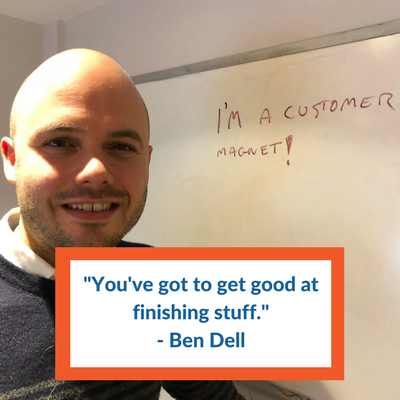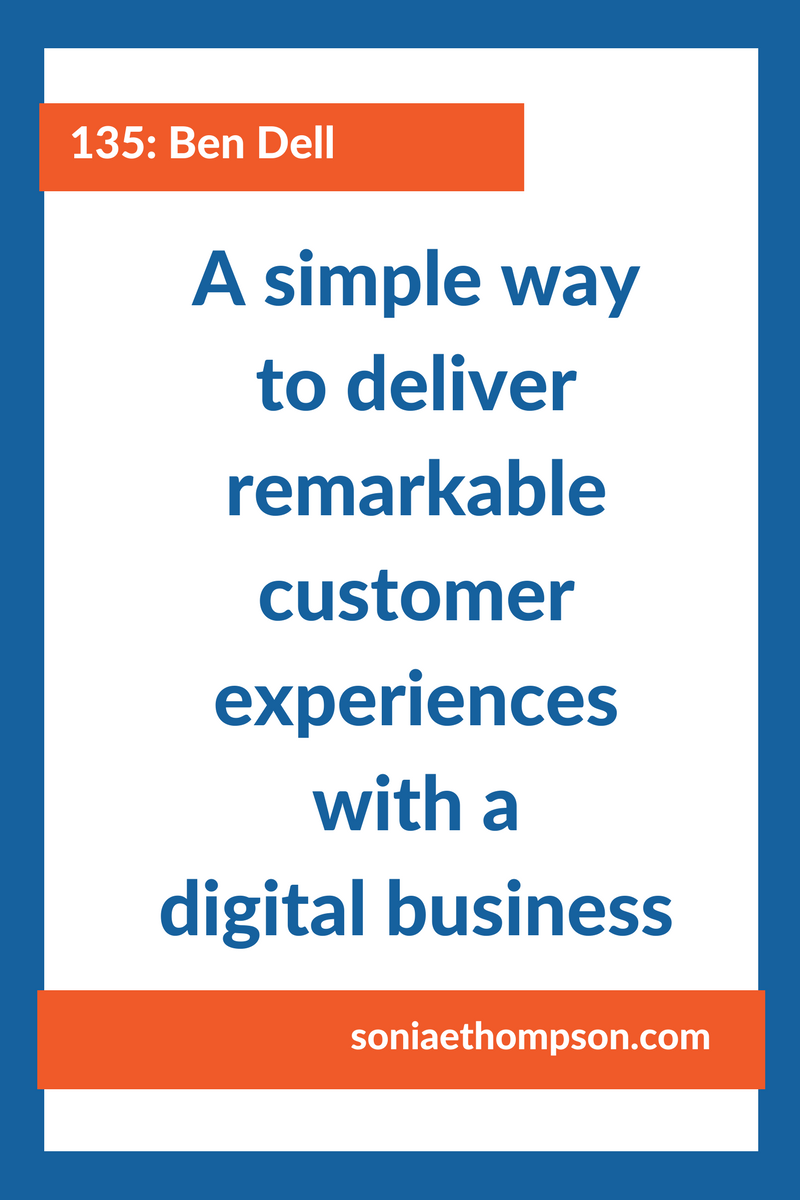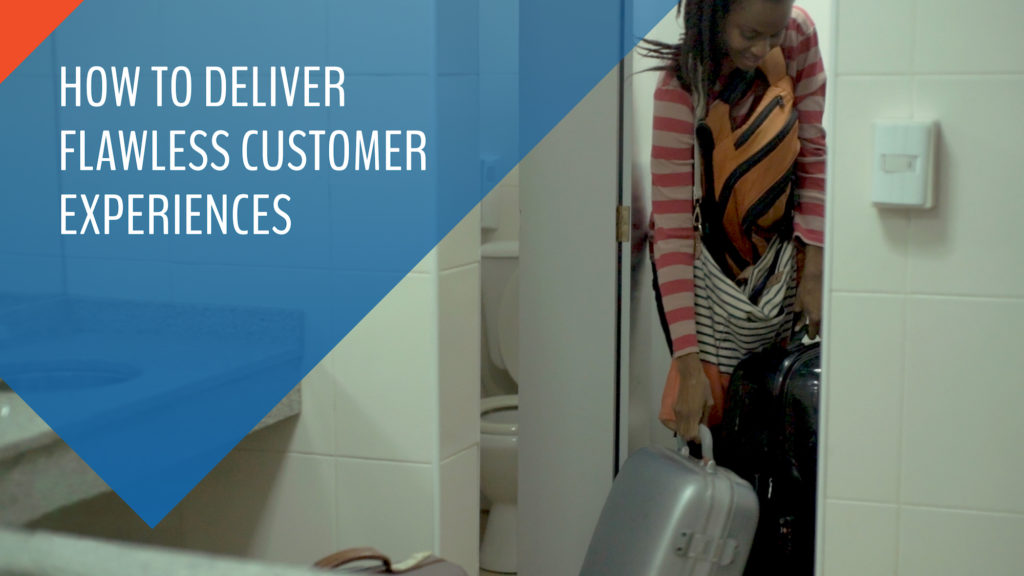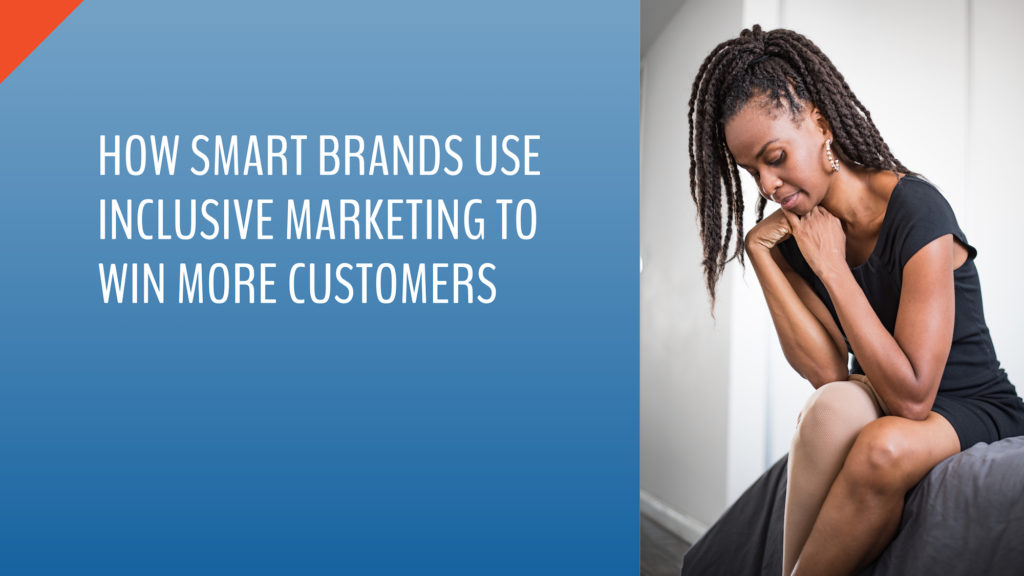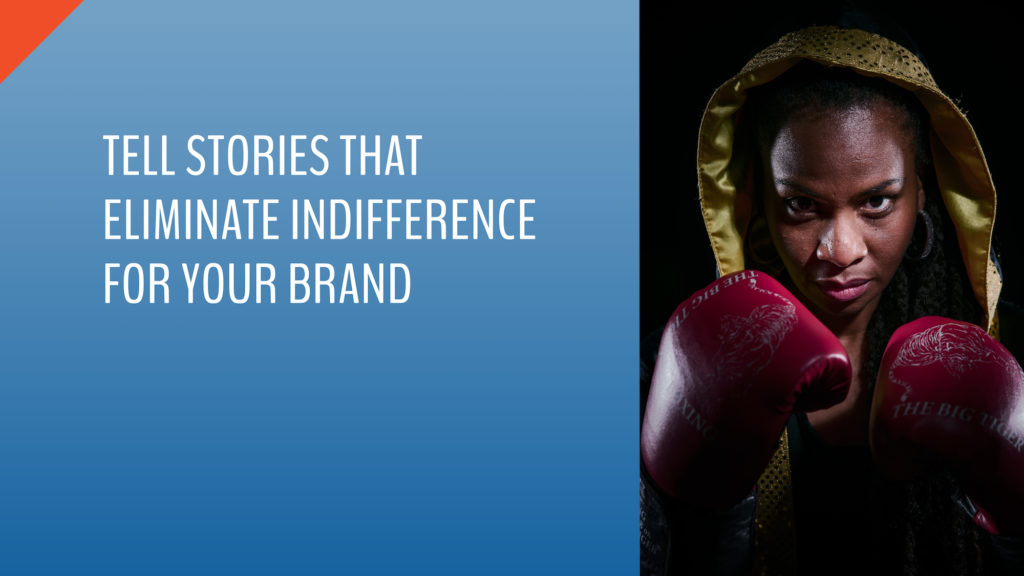Today, we are talking about how to deliver experiences your customers will love, even when your product and your company are entirely digital.
For insights on how to do that, I chatted with Benjamin Dell, founder of Missing LettR, a super cool social media management tool that I’m really excited about using for my own business.
We can learn a ton from Ben, in particular, what he’s discovered about how to create a “wow” factor with your products.
Key points:
- How to delight your customers with a digital business
- The only real way to create a “wow” factor with your products
- How to get longevity out of the ideas you produce
- Simple tactics that help you engage with your customers at a deeper level
- How to translate customer feedback into product solutions
- How to make sure everyone on your team develops a strong degree of customer intimacy
- The truth about to make decisions
Listen to the 31-minute episode here:
Watch the episode here:
Show notes:
Read the transcript of the episode here:
How to transform an unmet need into a remarkable customer experience
Sonia Thompson: Hello Ben, thank you so much for joining me today. How are you?
Ben Dell: Hey, very well, thank you, very well.
Sonia: All right, let’s go ahead and dive right in. Tell me about your business, the Missing Lettr.
Ben: So Missing Lettr … I suppose, one very short way of describing it is it’s Buffer on steroids or it’s Buffer without the requirement to turn up as a human and form healthy habits. Because I don’t know about you, but I have a Buffer account and I constantly forget to turn up because it’s dependent on me as a human to remember to write something new and to keep it topped up.
So but that doesn’t tell you anything about what Missing Lettr does so I probably should answer that. What we basically do is we turn our customers blog posts into social media campaigns. So we literally are monitoring your blog posts and when you next click publish on WordPress or whatever the platform might be, we run some clever technology over your content and what we’re looking for is interesting phrases and quotes and we’re recommending some hashtags, we’ll extract some images that you put in there.
We’ll also create some branded quote style images, using your own content as well. So you got a whole sort of stack if you will of media assets that we then turn into a 12 month drip marketing campaign. And that all happens within a matter of minutes.
So the next you hear from us is an email and it’s inviting you to review the campaign that we’ve just created you. Cycle through, make sure you’re happy with it, make some minor edit, click go and bam. We’re now gonna market it to your social accounts over the next 12 months and it’s all there to drive traffic back to your websites and to help you engage with your audience.
So that’s kind of … it does the bit before Buffer. So Buffer schedules your content and then it distributes it. We do the bit before that as well as scheduling and distributing. We create the content for you, schedule it and then send it out.
Sonia: This sounds fantastic. All right, we kind of explained a little bit but let’s go ahead and kind of knock it out very clearly. What is the specific problem that you saw for the people that you serve?
Ben: So I touched on it a second ago and it’s often cases one or two things. Either the habit aspect and we just forget to do things. We know, I mean most marketing is common sense. If you ask anyone for some good marketing advice, you’ll probably walk away thinking, “That’s obvious. I kind of knew I should be doing that.” But we forget to turn up and carry on and consistently do these things.
So one of the problems it solves is that we have a bunch of our customers who just are terrible at remembering to consistently market that blog post and to turn up on their social media channels. So we solve that.
And then you’ve got the other category who might well be good at it, and know they need to be doing it, but either don’t have the time or don’t have the money to pay someone else to do that. So we save a lot of time and a lot of money for people who might otherwise be paying a VA or an agency to do this stuff for them and it really just helps them get back to doing what their core business is all about, whatever that might.
How to deliver a remarkable customer experience with a digital product
Sonia: For sure, for sure. And I imagine that, you know, social media is something that businesses, all over the place, are really diving into, they know it’s something that they want to make sure that they’re having a presence on. So, what do you do to create a remarkable customer experience for people in that automated type of format where it’s kind of a low touch seemingly environment, how do you connect the dots there and how do you envision that?
Ben: It’s a good question because it’s something that really was the nucleus for the whole idea, really. Because we wanted to, from the very first go, we wanted to delight our customers. And as soon as you start … I mean, ultimately, what our business is is a marketing automation tool and that sounds very production line, very systemized. And the danger with automated processes like that is that you remove that enjoyment, that wow aspect and that human touch fundamentally. And we absolutely wanted to avoid that, we wanted people to feel connected.
And what’s something we have that’s very powerful with Missing Lettr is that we’re using our customers own content. So we’re not manufacturing something out of dust. We are taking content that you hopefully labored on and thought about really carefully and we’re just sprucing it up and sexy it up if you will.
So how we delight our customers is, right from the word go, within a few minutes of them publishing their blog post, one of the first things they see is an email from us with a beautifully designed quote bubble almost, speech bubble if you will, with their face on there, with their name and their brand, as they told us they want it to look. And an extract from their content and it’s … we still today, hear people say, this is fan- … you know, wowed, that they’re seeing their content repurposed in a way that just looks engaging without them having done anything. And that’s something that carries through the whole experience.
Sonia: Yeah, I can imagine. I’m wowed just listening to you. I’m like, “I gotta go see this thing.” So I’m excited to do that once we’re finished. Now, you mentioned you created this system, it’s automated, it’s a digital product, like you said, it’s not that human touch. Did you have to work … what was your process like to create this environment that makes your digital product deliver the experience that you want?
‘Cause your digital product of course does what you tell it to do, right? But I imagine you’re not the person who is doing all the coding, you probably got your vision for what you want your customers to experience and then you’ve got the people who are making your product actually come to life.
So how do you translate your vision and that feeling that you wanna convey, that delight, that excitement into actually the end product? Because I know a lot of times, people have the idea but they kind of fall short when it comes to actually figuring out how to execute it and actually deliver that feeling.
Ben: I’ve done plenty of that, I can promise you. Hopefully I’m getting better at doing it less often but for me, it comes down to two things. One, get as close to your customer as you possibly can, throughout. It’s not something you just do as a novelty because people have told you to do it in the first few days, it’s something that should stick with you throughout the growth of your company. No matter how big you are, stay as close as you can ’cause that’s the only real way that you can create that real, as you’ve said, sort of we’re talking about, touchpoint and sort of life I suppose, despite the fact it’s a digital product that could very easily feel very cold and very disconnected from the customer.
So stay as close to them as you can. And then, back to your point about ideas and it’s very easy to not execute on them. I think you’ve gotta be … it’s great to have wonderfully brilliant, exuberant ideas but you gotta get good at breaking them down into chunks. Cut up the elephant to fit it into a suitcase or whatever that analogy is.
Sonia: Right, right, right.
Ben: But if you can get good at delivering sort of micro-deliveries if you will, in a way that your customer is kept in the loop, so for example, we like to deliver something if we can once a week, at least one or two things a week. A mix of bug fixes as well as new features and new ideas. And we will always let our customers know.
So if a customer’s come to us on a Thursday and said, “I’ve got this bug or I’ve got a new idea for a feature,” we’ll make a note of that and when we maybe a week or two weeks later deliver that, we’ll loop back to them and let them know as well as obviously broadcasting it to the rest of our users. So the idea of delivering frequently and keeping the customer very very close is integral.
Sonia: Got it. Now I am in complete agreement about making sure that you’re in constant communication with your customer and developing that degree of intimacy with them so that you know what it is that they need. What does that look like for you in your company?
Ben: So, when I hear the word intimacy, I kind of just think … I translate that to be human, quite frankly. And I think there are, again, it’s very very easy, particularly in a digital product where you don’t have a physical store or a real touchpoint with the customer, just to think having the product that people are using is good enough. Now you need to have those daily, monthly, whatever those other touchpoints are with the customers.
And as long as you do it, and it’s really simple, as long as you do it, as far as I’m concerned it anyway, as long as you do it in a human way, in a way that puts your vulnerable side across and you don’t put … so for example, we use Intercom and it’s another automated tool for our communications but whenever I sign off, I always start the communication with Ben here from Missing Lettr and I always sign it off with my name as well, my first name, no surname.
And I sort of say, look, I check and read every email, pop a reply, I’ll get back to you. And the picture I have is me with my dog. Now it’s just stupid little things like that but it’s there throughout. It’s not just a novelty. When our customers engage with me and anyone else from my team, they pick up on that, throughout the whole experience and it delivers that intimacy that I think keeps our customers with us.
Sonia: Does that intimacy sort of …cause what you describe is really a connectivity, both with your product but also with you, the maker of your product. So it’s not just the Missing Lettr, it’s Ben, and the team and everyone else which, I think you said it, it makes it a little bit more personal.
Ben: Yeah, and now whether that scales or not is another thing. Does it scale for me to be … I mean, I don’t send out all the emails of course but does it scale for me to be fronting the ones that I do and for me to be replying to them all, I don’t know. But what I can tell you today, I enjoy, I get a kick out of speaking with my customers first hand and hearing them.
When they reply to think it’s just going out into the ether and then immediately, almost immediately, I get a reply. It’s great. I’m delighting them and it’s fun and we learn something from it which is cool.
How to translate customer feedback into product features
Sonia: So how do you take what they’re telling you and prioritize that into those updates that you’re going to be deliver. ‘Cause I’m assuming that they’re not always telling you exactly what it is that they want. Like they’re saying it in a different way than … they’re not saying, “I need you to do xyz specifically.” You kind of have to read between the lines, sometimes. So how do you go about doing that?
Ben: Yeah, totally. I mean I’m gonna sound like I’m contradicting my previous point a teeny bit. Yes, you need to keep your customers close to you but equally, you need to know how to keep a bit of distance as well. Because at the end of the day, you have to feel confident in the vision that you’re trying to deliver here. And have a bit of sense as to … have a bit of an instinct, a gut instinct on what you’re trying to achieve because as you say, you might have 10 customers, telling you … you might ask 10 customers the same thing and they’ll give you all different answers or ask one person for some feedback and they’ll tell you in a way that maybe isn’t quite telling you exactly what they’re feeling.
Or maybe it is but maybe they’re emphasizing it in the wrong way. So I think it takes a bit of experience, I think, and it’s taken me a while to learn to listen but know when to cut that off and roll on your instincts because, otherwise, you just fall into this trap of just delivering feature after feature that people are asking for and you know, with the best intentions. Customers don’t always know what’s best for the company as a whole. They might know what’s right for their own little silo, but that could completely bring everything down crumbling if you’re not careful.
Sonia: Yeah. Now what would you say has been the biggest barrier that you’ve experienced, that’s limited your ability to consistently deliver a remarkable experience for your customers and how have you worked on that or overcome it?
Ben: So that’s an easy one. It’s a technical one. So we obviously connect with or send out content to Facebook, LinkedIn, Twitter, Google Plus and almost Pinterest, we’re just rolling out the beta. And we’ve had some, we’re sorted now, but we had some horrible issues with Facebook. We have 10,000 plus users at the moment and it’s not a massive number but it’s a healthy number and that’s a lot of content being sent out to these social networks every day.
And what you don’t want in that situation where your product lives and dies on content being delivered, I mean, when it all comes down to it, people want their content delivered. You don’t wanna wake up on a Monday morning with an email, an automated email at that, with a no reply-reply from Facebook saying, “We detected that you’re using our API in a slightly wrong way, we’re gonna shut you off. Click here to appeal it.”
Now it’s not a ban or anything, it’s just, we’re gonna turn it off until you’ve rectified the thing. But no warning, no sort of, “We’re gonna turn it off tomorrow.” And no way to properly reply. Anyway, we’re all perfect now and I’ve got a contact there and they actually realized they were looking at what we’re doing in a slightly wrong way. But yeah, it’s things like that, it goes to show how, doesn’t matter how great these touchpoints are with the customer and how great the idea is, there are fragile points in every business.
And you know, you can do a bit of risk management but sometimes the shit hits the fan sometimes and you gotta … there’s very little you can do, sometimes. So it takes patience and a bit of control and perseverance, I think.
Sonia: So you brought up another good point. Like there is delivering your customer experience but you can’t do it 100% by yourself, you’ve gotta have these partners. So, how, given that experience, like you said, I’m glad that you’ve been able to fix it, have you had to put sort of parameters or specific areas in your business to help make sure that you grease the skids or whatever with your partners and maintain that relationship so that they assist you in your mission versus sort of hindering you in any sort of way?
‘Cause things like this can pop up all the time as they change their rules and-
Ben: For sure, yeah, yeah. It takes a bit of common sense and also a bit of slowing down. So I love this idea of releasing things frequently but when it comes to things like that, when you’re maybe tweaking a feature or the way that you interact with a partner like Facebook’s API or whatever it might be, you gotta learn a bit of self-control which I don’t know whether I’m there yet. But you gotta learn to just think about what you’re doing and engage with the customer, make sure it’s right for them, engage with the partner.
It takes a bit more time and a bit more thought. But the worst thing is not knowing what those risk points are. Once you know them, you can kind of … it’s fairly easy to work around them. And my team, they know that if anything like this happens again, if we suddenly get an email from a partner saying, “We need you to fix this or that,” then these are the sort of things that needed to be jumped on immediately because they have such a huge impact on everything that we do.
How to effectively serve customers from around the world
Sonia: Got it. Now I know a lot of your customers have the same core problem and you described it in one of two ways. But as you think about customers around the world, they’re increasingly becoming more and more diverse in terms of their backgrounds, their experiences, the way they view the world, the way they experience the world.
So have you had to adjust the way you operate your business or approach these different customer groups to be able to accommodate that or does it differ for you because you’re targeting people with a specific need?
Ben: It’s probably to be fair more of the latter. But I do think we … I’m trying to do as much as we can, organically I think and not too rushed to do more of what you’re talking about because in many ways, there isn’t any … I mean, it depends. I don’t think … there’s a limit, certainly. I mean, you can take it so far and say, “Well, we’re only gonna … we’re gonna send this email to people with blue eyes and this email to people with green eyes.” I mean, there are limits, of course.
But, I think it’s fairly easy for us to do things like that and be a bit more thoughtful about how we target certain communications and certain experiences because in essence, we do have that data available to a certain extent.
Now we already send specific emails and different promotions and different things to different segments of users but that’s not necessarily based on their backgrounds or their position in the job and that sort of thing. So there’s a lot more we can do.
I mean, one example. We did a deal for … so we’re based in the UK but we are still aware of the notion of Black Friday, it’s kind of trickled through to the UK in the last few years. So we know what it’s all about. And as any good business owner, I wanted to capitalize on the opportunity that that holds and we wanted to offer a deal to our customers.
So we sent out an email to all our customers, sort of Black Friday last year, so a few months ago. And we got some good reception of it. But we had one lady from Australia who was really frustrated and annoyed because she had no idea what Black Friday was. And was frustrated that it was put upon her to look it up on Google and find out what it was. And you know, it’s a fair point. And whilst it’s completely impractical for us to … you know, we have customers across close to 100 countries and it doesn’t make sense that we would look at every single country to make sure that any language we’re using is familiar in that country.
And yet, you can kind of see where she’s coming from. So it’s an interesting topic because there is … you can never reach perfection, I’m pretty sure. And if you do … to reach perfection, you probably need to know so much about that person that you’d be invading their privacy. You know, to really know, you know, what day do they get their hair cut, you know, silly little things. So, it’s an interesting one.
Sonia: Yeah, I like how you’re thinking of it and that was a great example in terms of you know, she didn’t know what that was and sometimes some things that are so simple we take for granted that everybody might know this or everybody celebrates this but yeah, there is a degree of carefulness that you have to have but it doesn’t always mean that … you’re not always gonna get it right but as long as you’re trying, it makes a big impact.
Ben: Yeah, unfortunately, putting stuff out there and actually just delivering things, whether it’s an email or a business or a product or an idea, whatever it is, you’re never ever gonna please everyone and I mean, sometimes there’s things you can do to fix it next time but ultimately, you’re gonna upset people sometimes.
How to build a high-performing team that solves your customers’ problems like none other
Sonia: For sure, for sure. Now what do you do to cultivate a high performing team that enables you to solve your customers’ problem and delight most of your customers most of the time. Like you said, you can’t do everybody all the time, but how do you cultivate a team that allows you to be able to do that? ‘Cause like you said, as you start to scale, that’ll become more important.
Ben: Yeah for sure. So we’re a smallish team at the moment, there’s four of us at the moment. So we are not yet at that point where … you know, we have the complexities of scaling a large team and real complexities will drop in there.
But without sounding like I’m a broken record, the way I do what you were just talking about there is really just to make sure that the customers are not just close to me as the business owner but are as close to the day to day life that my team play out as well.
So not just the customer support person knows what the customers are saying but they share that with my team in the Slack channels and vice versa. So there’s never a sense of someone being completely safe and cocooned in their own little world, unable to just get on with something without repercussions. We all know together what the business is doing, what the risks are, when something goes terribly wrong with a customer, we all know about it and we feel that pain and that heightens our alertness and our desire to improve next time. And it keeps us all responsible for our own actions in many ways. Whether that scales, we’ll see but that’s kind of the principle.
Sonia: Got it. And how do you go about … ’cause you mentioned before that you can’t always listen to … you wanna listen to your customer and know what it is that they want from you but you also kind of have your own lens in terms of what is the vision from the company, what the market is doing. How do you tend to balance that with you and your team and making sure that you’re both forward looking and sort of balancing that with your customer with what’s going on in the market?
Ben: Well, it’s simple. I’m the king, and my team … no, I’m joking. I guess, it takes experience and just making mistakes along the way because when it comes to an idea and I think I know best and I … but I’m learning slowly to sort of take on advice from other people and just play a slightly different game.
But it’s difficult. I mean, it’s something that I think it helps to discuss with your team, so not just dictate what you’re gonna do, whether it’s fed from a customer or not but to actually involve the team so that they can be part of that story at the very, very least and that motivation.
Sonia: Great. And what is your approach to failure? ‘Cause like you said, it comes from experience but experience brings with it a lot of failure. So how do you all as a team approach that in your business?
Ben: So, the way to approach failure is just to accept it, I think. And to start failing, quite frankly. So again, we deliver quite frequently our new features, new products and you know, you could argue and maybe we will have to do this when we’re at scale but we’ll have to slow down our cycle and maybe once a month we do it because we’ll have a team testing and this person doing that.
But right here and now, we’re such a small team that we’re able to deliver much quicker and the downside of that is that we fail a lot more quickly. So we will deliver something that we think is perfect and sometimes we’ve done something in the wrong way, we have to rethink. And we deal with that by just analyzing what that failure actually means. Because failure is so nuanced, it’s not black and white, doesn’t literally mean that was a total failure, just means an aspect of it was not so perfect.
So kind of part of the challenge is working out which part of that thing that you in theory got wrong was actually wrong because it might be that the idea was great and the execution was great but maybe the follow up was terrible or the timing was off. And that just takes, again, engaging with the team and just trying to unravel it all.
Sonia: Okay, good.
Ben: Get good at failing, that’s what it’s all about.
Sonia: Absolutely. It’s the name of the game. What would you say are your three keys to business success?
Ben: I had to write this down when I saw this as a potential question before because if you ask me on a given day, I’ll probably give you three totally different things. I thought, just take the time, let’s just think of something that doesn’t sound like it’s completely tripe and made up.
So but these are things that I think hold quite true to me. One is, trust your instincts and these are things we’ve spoken about for the last half an hour or so. Trust your instincts because you can’t depend upon someone else’s. You might have some great advice from someone but at the end of the day, you’ve gotta roll on your instincts.
And you know, that sort of filters into the second point which is get really good at listening. But know when to then roll with your instincts and actually follow through. Because you could listen to your mentor, you could listen to your masterminds, your team mates, your customers but you’ve gotta think about, as Steve Jobs would call it, where is that puck going to be, not where is it now?
And then finally, great ideas only matter if you can actually deliver them. And if you’re not good at delivering them, maybe just break them down into smaller chunks but make sure you deliver. Give yourself something … so I famously in the house eat lunch at whatever time, I don’t have a fixed point because if I set myself a target to do in the day, on the morning I should say, I won’t stop for lunch until that thing is done because I just find … it’s horrible to leave something just unfinished.
Now that’s just me being a bit extreme maybe but you know, at least finish it by the end of the day or have a deadline by the end of the week. Get good at finishing stuff because there’s too many people in this world who have great ideas and just are terrible at seeing them through.
Sonia: Very true, very true. Ben this has been great. Any parting words or wisdom for businesses who want to consistently deliver remarkable customer experiences for people they are serving?
Ben: What I would just do is I would just re-tweak some of the stuff we’ve already spoken about around the customer and just give you a different perspective, a different way of thinking about it. And this, I have to confess, is stolen from a guy called David Cancel, ex-guy from HubSpot, guy who runs Drift now. Really, really interesting guy.
And he constantly talks about this idea that decisions you make should be customer focused, not company focused. That sounds … and what that means is, don’t just optimize something because it benefits you or the company. You know, so I had a team member a few days ago who was just doing a proof of work for a feature and gave it to me to review. It was nowhere near ready for production line but that’s not the point.
And I asked him, “Why did you do it in that way?” And he goes, “Well, it was the quickest thing to do and that’s the way we store the data in the back end, bla bla bla.” And I thought, “How is the customer gonna understand what that means and how are we gonna lead them through that process?” Just having that form on the page is optimizing it for us, as a business.” It’s the quickest way, it’s the most effective, it’s easier to maintain but that’s terrible for the customer.
So ask yourself at the end of each day or at the end of each strategic meeting, have we made those decisions for the benefit of the customer and the market and everything else or have we done it just simply to optimize the company and our bias and everything else? I find that really helpful to think about sometimes.
Sonia: For sure it is. And where can people find you if they wanna learn more about this great product?
Ben: So Missing Lettr can be found at missinglettr.com and as the tittle would suggest, there is a missing letter from the title, Missing Lettr. Just to confuse things. And this sounded like a great idea when I came up with the name a couple of years ago but quite bad to explain every time. Maybe proof that it’s not. But the E from letter at the end is missing. So it’s Missing, M-I-S-S-I-N-G, and Lettr, L-E-T-T-R dot com.
We have actually since acquired Missing Letter, the full spelling, but that will just redirect you, if you’re lazy, that will redirect you to the main spelling. Missinglettr.com. And I can be found on Twitter although I need to get more active on it, at Ben Dell, B-E-N, D-E-L-L.
Sonia: Sweet. And I’ll have all the info in the show notes so people can contact you and reach out to you.
Ben: Cool.
Sonia: All right. And before I let you go, I do have one other question, just to jump inside your mind a little bit more. And that’s, deliver a line from a move that speaks to you and explain why you chose that one.
Ben: So I definitely had to research this one because my wife is always telling me off for what I think of really, really good impersonations of certain things from certain movies and the reality is, and my wife is … well, I was gonna say almost always, she is always right. I’m terrible at these things. So I’m not gonna be clever.
So it’s one of my favorite films, it’s Shawshank Redemption and there’s a quote in there, Get busy living or get busy dying.
Sonia: Yeah, yeah. Why did you choose that one?
Ben: It’s short, it’s simple, it’s binary. You’re either doing it or you’re not and you know, you gotta get up and out and then do something, whether it’s delivering that thing, it’s not good enough just to think about doing that thing, you’ve actually gotta do that thing and they don’t skirt around the subject and sort of describe what living means and think about standing up or not sitting down on your sofa if you will. They just say, “Live,” and you can translate that into anything you might do.
Run a business, go out and learn to run a marathon, whatever it might be, get up and do it, there’s no excuse.
Sonia: Love it. And I love that movie, great movie, great line.
Ben: I know, it’s great, isn’t it?
Sonia: Great! Ben, again, this has been fantastic, thanks so much for stopping by.
Ben: Thank you, my pleasure. Thank you.
Free Mini-Course: The Customer Magnet Playbook
Free Mini-Course: The Customer Magnet Playbook
7 Essential elements your business needs to consistently win more customers
- Framework based upon in the trenches experiences from 150+ business and thought leaders
- Science-based explanations to support why the elements of the blueprint work
- Action items to help you get some quick wins

